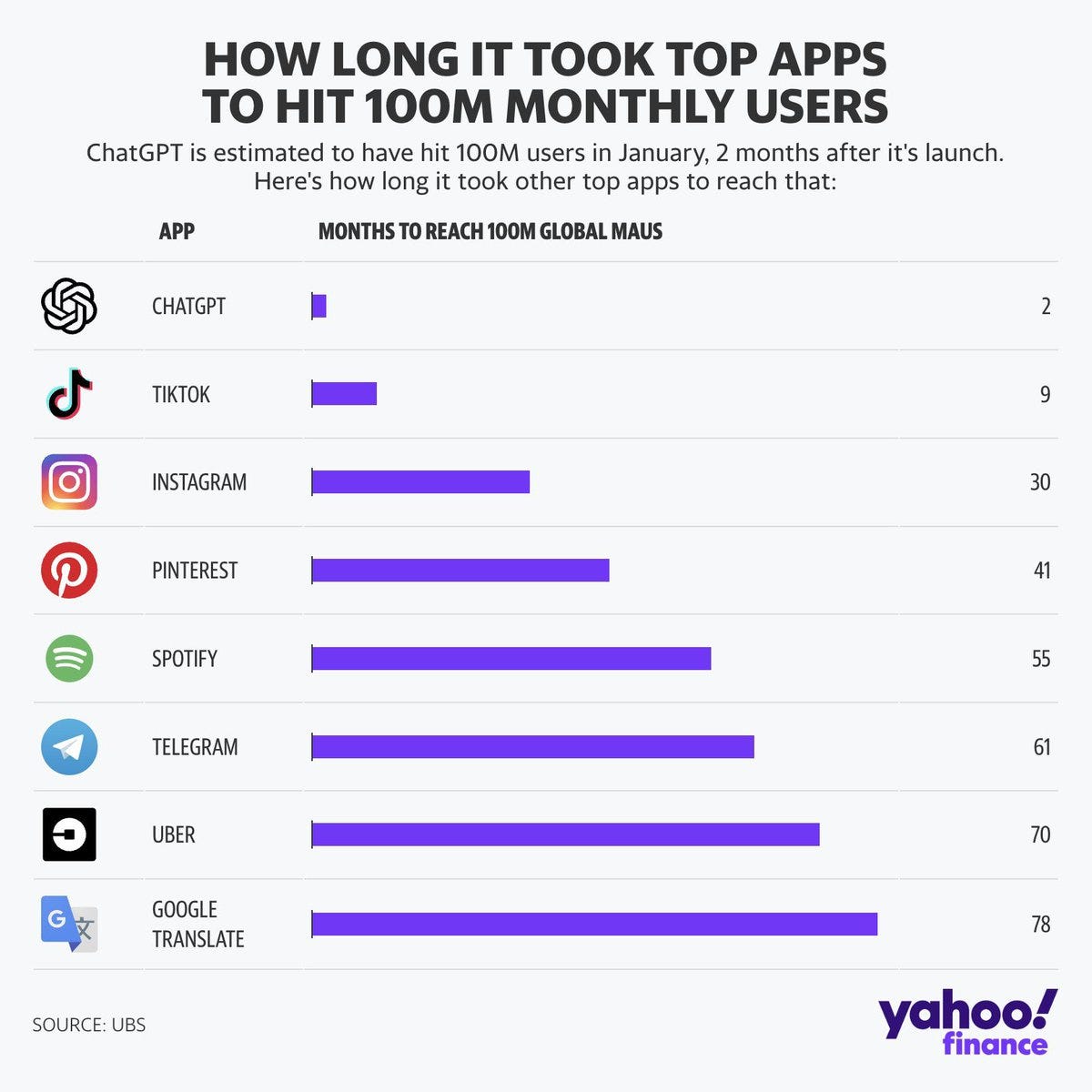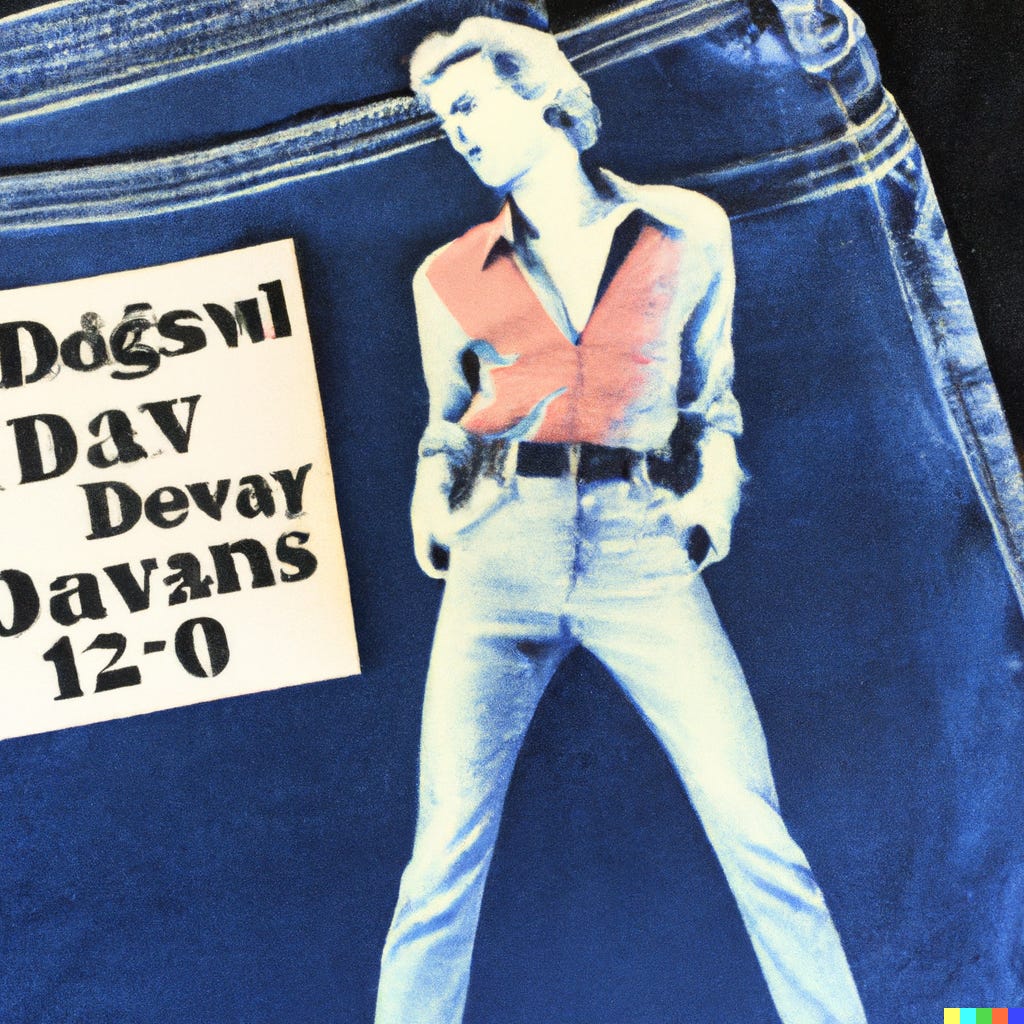An Umami Martini & How Generative AI Will Transform Commerce & Marketing (Pt 1 - Personalization & Content)
Issue No. 5 - March 9, 2023
Only five issues into the newsletter and the feedback has been terrific - thank you. If you are enjoying it, please share by forwarding the newsletter via email or LinkedIn. I can appreciate your support, and certainly hope to grow the subscriber base over time. Thank you!
I am once again pairing the cocktail with the topic! With this week’s newsletter I dive deep into how Generative AI will transform digital commerce and marketing - and decided to pair that with an umami Martini - a delicious twist on a dirty Martini.
This Week’s Cocktail: The Perfect Umami Martini
The Martini is both a signal of sophistication and the perfect party starter. It has in many ways become the ‘it drink’ of our times - it is clean, minimalist, and a throwback all in one.
I tend to like my Martinis closer to a classic 50/50 split of London Dry gin and a great vermouth. But as one of my favorite mixology sages, Sother Teague, once said to me, “Martinis are like eggs, everyone likes them a different way and they are all right.” (I tend to agree with that unless that someone orders a dry vodka martini with no vermouth - because that is just a cold glass of vodka!)
The dirty martini is built upon years of Martini tradition and experimentation - it is salty, and at its best it is umami. Umami - for those unfamiliar - is a term used to describe the ‘fifth basic taste’, alongside sweet, sour, salty, and bitter. The word umami comes from the Japanese word for "delicious" or "savory" and is often described as a savory, meaty, or ‘brothy’ taste and is caused by the presence of glutamate - an amino acid found in many protein-rich foods.
This spec is one I developed through some trial and error as I sought to take a classic Dirty Martini to the next level. My wife loves Dirty Martinis, and her late father who loved them too. A few times a year we make a batch and drink to his memory - and he was a bit salty and ‘brothy’ too, so it fits. I found that the inclusion of two bitters - Japanese Umami bitters, and DeGroff Pimento bitters - really made the drink take on a nuanced, and yes, umami quality that I love. These bitters are excellent and a great addition to any bitters collection.
As for the gin, when making a Martini I like to use a classic, clean gin that does not compete with what I am mixing with. There are lots of excellent gins on the market, but many “new gins” are herbaceous and in my view are better in a G&T or gimlet. In a Martini those herbaceous gins can compete with the vermouth and other modifiers. For a Martini, my advice is to use a straight-forward London Dry, and Beefeater more than fits the bill here. Plus, it is inexpensive and easy to find. For the vermouth, a good clean, dry vermouth is what you want for this drink. You can’t do wrong with Dolin Dry, and it too should be fairly easy to find as well.
In a Dirty Martini, a critical ingredient you can easily get wrong is the brine. A good brine is really important - after all, you will be using half an ounce! I have tried lots of them. If you have a jar of olives in the back of the fridge you are tempted to use, taste the brine and decide if you like it. It may be old, stale, or just not the flavor you want. One olive brine that I consistently use for Dirty Martinis is the Napoleon Pimento Stuffed Olives brine. Again, these are easy to find in almost any grocery store, and the olives are good as well.
And one last point - a Martini of any kind should be served very cold and ideally stay that way as long as possible. Put the glasses in the freezer ahead of making the cocktail to get them damn cold - 30 minutes or longer. If you are like me, and your freezer is nearly always full, fill your glasses with ice and let it stand until you are ready to serve - then discard the ice (or the melt water, so you can use the ice in the next drink!)
The spec:
1.5 oz - Dry Vermouth (Dolin Dry preferred)
1.5 oz - London Dry Gin (Beefeater is great here, so is Botanist)
.5 oz - Olive brine (Napoleon Pimento Stuffed Olives brine recommended)
2 drops - Japanese Umami bitters
1 dash - Degroff’s Pimento Bitters
Three olives, skewered, for garnish
The process:
Add all ingredients to a cocktail mixing glass (beaker or pitcher for substitute) then add ice and stir until well chilled. Strain into a cold Nick & Nora coupe or martini glass, and garnish.
Analysis: The Impact of Generative AI on Commerce & Marketing - Part 1
OK, I will admit that I was tempted to use the party trick of starting this article off with a bunch of expected - and otherwise very plausible - prose generated by Chat GPT before I hit you with, “Surprise, this was written by Chat GPT”... but that is so last… week. (Literally, just watch John Oliver’s segment on Last Week Tonight.)
By this point, you may be like me and are feeling both a bit bored and sick by all the talk and news coverage about Chat GPT - or Bing or Bard or Mid-Journey or Sydney or etc.. According to the mainstream media, Generative AI is both coming for our jobs and making your college degree meaningless (even though you may have realized that already, this feels different).
You are probably also wondering how all of the sudden every sales development rep suddenly became interested in poetry as you clean out your inbox - just as your kid saunters into the kitchen for a snack and declares they are done with their homework. You ask if they need help editing the essay due tomorrow on the Louisiana Purchase, and in reply they declare, “No, I’m good.” Naturally you are going to wonder if they are one of the 100 million active monthly users of Chat GPT.
Holy crap this is huge.
It is both notable and astonishing that ChatGPT - the current poster child of generative AI - reached 100 million active users in under 60 days. It took Facebook four years to reach the same number of active users. So, ya, it’s kind of a big deal.
If you have played at all with Chat GPT, Dall-E, Midorney, or the host of competing writing and design tools that have launched recently, you probably have reached a similar conclusion - Generative AI is going to have a massive impact on many, many industries and aspects of our societies. There will be both very good and very bad that come from it, just as have come from every other major major human innovation (see: wheels and fire).
Many have been commenting - such as here, here and here - that Generative AI may be the most significant technology innovation to impact human culture and commerce since the iPhone launched in 2007, or for that matter, maybe the Internet itself. Frankly, I don’t think that is over-stating it.
But of course it is early days for Generative AI.
For as much of a splash Open AI’s Chat GPT has made, it is not even clear if they will be a winner in the end (Netscape anyone?). There are limitations on the data indexed, there is more training and advancements in the models yet to come. Chat GPT for example is trained on a dataset called the Common Crawl and took a snapshot of that to train on in 2021. Common Crawl is basically just a very large collection of web pages crawled from the Internet (which we know is always correct! What can possibly go wrong ?!?). And human beings have also been involved in training these models - Google, for example, recently asked ALL of their 190,000 employees for help training Bard - naturally introduces bias into these models. In fact, much ink has already been spilled about how these AI models can get it wrong today - “hallucinating” and making stuff up - or worse, claim to fall in love and act manipulatively.
But let’s be honest with ourselves here, it is so early. Go back and read an early critic of the Internet complain about dial up modems and poor UI, have a sip of your Umami Martini, and have a chuckle while you realize we are at the dawn of a new transformative period. These models are evolving quickly, using more sophisticated learning models, and will soon start to use current data such as websearch does.
BTW - If you want to geek out and really understand how Generative AI works - and what a Large Language Model is and is not - I encourage you to read Stephen Wolfram’s What Is ChatGPT Doing … and Why Does It Work? On some levels it is really rather simple and the research these are built on has been going on for decades, while it makes sense why the cloud computing horsepower and modern computer science of today make it possible. And while I am not getting into the ethics or existential questions revolving around Generative or General AI, if you are interested, this is a great long read on that from the Intelligencer.
But let's stop focusing on generalities and instead, let's focus on the applications and implications for commerce and digital marketing.
Let’s not bury the lead: Generative AI has the potential to radically transform digital commerce & marketing.
What makes this so compelling - so big - is that that transformation will be both inside and out, meaning both the customer experience and the back-office in digital commerce and marketing will be massively impacted. It is such a big topic that I am breaking it down into parts. I will get into later ‘parts’ of this in follow-on editions of the newsletter. For Part One, I want to focus on Personalization and Content.
First let’s look at how Generative AI will unlock a huge barrier in personalization.
Personalization is a hot topic for a reason. It can both improve the customer experience and generate meaningful business results. McKinsey Research has some powerful research showing that customers want personalization - seventy-one percent of consumers expect companies to deliver personalized interactions and seventy-six percent get frustrated when this doesn’t happen. And a recent CommerceNext survey confirmed that personalization is the top priority for U.S. e-commerce business investment in 2023.
Much has been said about how critical customer data is to enabling the power of personalization, including by me. That has of course driven hundreds of millions of dollars in software and services that businesses have spent to implement customer data platforms, data lakes, and bespoke analytics applications - often on top of massive cloud data storage and application environments that drive consumption of AWS, Google Cloud, Azure, etc.. That has also driven tens of billions of dollars in valuation of the software companies that provide those solutions - including Bloomreach. None of that focus on customer data and machine learning in the service of personalization is a mistake, but it often leaves out a critical component needed to make personalization work.
The hidden challenge of personalization: Content
There is a hidden challenge that is often not discussed with respect to personalization - what assets are you going to apply that personalization to? There is a good and practical reason why for the last twenty-plus years most e-commerce and marketing personalization has focused on products, as in product recommendations. That is because in an e-commerce setting the content for the products exists.
To go beyond that - and the finer grained your segmentation and the more advanced the personalization goals you have - the more content you need. Even just multiple variations of web-banners, merchandising assets, email copy, and email content is often too laborious and time consuming for most organizations to create. Most e-commerce businesses struggle to get one version of everything done in time with the resources they have - and can afford - let alone many. For example, even with Bloomreach many customers are limited in how far they can take their personalization goals given the lack of content asset variations beyond products.
And of course, the power of personalization is all the hidden pockets of opportunity that humans will struggle to identify and test, whereas modern machine-learning applications like Bloomreach and others can.
Content and the structured data needed in e-commerce has been labor intensive and expensive for a long time, and Gen-AI will change that.
Since the dawn of DTC - including catalogs and advertising -writing good product and marketing copy has been a creative and content production grind. In the e-commerce world structured data about the products adds to that - attributing products with descriptions and attributes like materials, applications, colors, finishes, style and decor types, care instructions, category, features, benefits, specifications, dimensions and weight, country of origin, compatibility, warranty and returns, and even safety and compliance. Ya, don’t kid yourself, even when manufactures send content over it usually not very good.
And many back office systems - like ERPs and PIMs and PCMs - have crappy data that looks like it was spit out by an old mainframe that is older than HAL (Yes, that is of course a reference to one of the greatest science fiction novels and films ever made, 2001: A Space Odyssey - which were jointly released in 1968!) That product content and data needs a lot of massaging and in the past that has been done by people, and shockingly, usually in a spreadsheet.
Getting all that right and ready is a pain and is costly. The nice long product descriptions themselves can easily cost $50-200 per product - I mean you want these to reflect your brand, right? And how about making them feel original and fun? You want them to be actually interesting? Let’s face it - and I really do not want to offend here - for most this is already a game of copy/paste for many copywriters who struggle to drive originality in the face of deadlines and distractions and poor tools.
Well, the arsenal of tools just got a whole lot more interesting.
I asked Chat GPT to write a product description for a slim denim jean in the style of David Bowie (because I was listening to Hunky Dory - do yourself a favor, put it on now, because it is great!) and here is what Chat GPT gave me, word for word:
Introducing the Rebel Rebel of denim jeans – the one and only, Stardust Denim. Slip into these sleek and stylish jeans and you'll be ready to hit the stage in no time. With a slim fit that's just tight enough to make a statement, these jeans are the perfect addition to any rocker's wardrobe.
Crafted with precision and designed to shine like a diamond dog, Stardust Denim features a unique fade that's reminiscent of a starry night sky. Let these jeans take you on a journey to the outer reaches of space and time, where you can be a hero, just for one day.
Whether you're strutting your stuff on the streets of New York or performing to a packed arena, these jeans will make you feel like a modern love superstar. So don't wait any longer – join the fashion revolution and embrace the power of Stardust Denim. Rebel against the norm and show the world what it means to be a true fashion icon, just like the one and only David Bowie.
It may not be perfect, but it is pretty damn good - a bit of editing and you may be good.
If you understand what Chat GPT is doing in the background to produce that, it makes sense - it is a mashup and a copy & paste and a blender of words all in one. And of course paired with image recognition and other types of AI and you can see how these processes will become far more streamlined and efficient while quite possibly leading to more creativity and experimentation. Already people are writing integrations from Google sheets and databases to Chat GPT and creating this stuff.
So, will Chat GPT make writers obsolete? No. It will make them editors.
The skills the best copywriters need today will transition from cranking out content, in other words -creation, to editing and curating. Any journalist, analyst, or creative writer who has worked with good editors will tell you that the skills are different. And frankly, these implications will extend to all kinds of writing. (We should start teaching everying how to be a good editor - versus a good writer - to everyone starting now. That includes kids.)
And of course the power of Gen-AI will be its ability to scale the multiple variations of text and structured data to personalize with and test. That is why Generative AI is the real enabler of personalization at scale.
We also already see this being applied to email subject line testing, and more will follow soon. Of course, the content alone will not suffice, you need a powerful, real-time machine-learning application to take advantage of all that content and test and optimize at scale to take advantage.
And what about images and graphical content? Not quite so fast, but maybe soon.
The other critical and costly component to e-commerce and marketing content is of course photography and graphical content:, such as:
Product images & videos: High-quality photos and/or videos of products that show them from various angles and in different contexts - flat, on model, 3D, in a lifestyle or use context.
Video content like product demos, tutorials, and lifestyle/brand content that can help customers better understand and use products - or just be inspired.
Home page, category page and landing page graphics that are designed and created to promote events, collections, products, services, or offers.
Blog posts and articles that are used to add value to customers and express the lifestyle and enhance the brand, or how to use the products and the value they add.
Graphics used in email marketing, newsletters, display ads, and social media marketing.
All of those today require people on keyboards and a whole business process to direct, manage, approve, and publish.
Photography alone is a very costly and laborious process. Decent flat product photography is typically going to run $20-100 per photo, while on-model will by 5-10x that and lifestyle photography - showing the product styled and being used - will be at least double that. And of course if you are using celebs or supermodels, well, it will be even more. You want video? Well, the costs go up from there.
Film makers are already skipping on-location shoots and using computer generated backdrops that are not just filmed without the actors, they are CGI from scratch. It is quite likely that today - or very soon - that next series you binge will have highly realistic “sets” that are created with generative AI with the actors just acting in front of a green screen - let alone the scripts, edits, scores, and so on. And yes, in the not too distant future… Do we really need a live actor? (“I want Steve McQueen for this one!”)
The opportunity for Generative AI to dramatically improve the economics and scale of graphical content in e-commerce is massive. Paired with the personalization and optimization technology we have available today - let alone how it may continue to improve - will unlock the potential for personalization to deliver on the promise we have been chasing for well over twenty years now. We can also easily imagine these systems becoming faster, and even able to respond to the customer attributes and intentions we now can model in our customer data and personalization systems in tenths of a second. That will feel like real time to a human and lead us close to the types of 1:1 marketing we have been talking about for decades.
But we are ways off - the fidelity of the image and video generative AI tools is still lacking.
I asked Dall-E to give me an image of that same Bowie denim jean, and it is hard to say this is what I had in mind, and I don’t really think Bowie would have ever worn these:
And here was an attempt at “David Bowie Ziggy Stardust Jeans Sale”:
I think it is fair to say that neither of these are very good, or very compelling. But we can of course expect this to get a lot better. And what is really powerful is the variations you can imagine creating using vertical-specific e-commerce and marketing tools.
We will see these vertical specific Generative AI tools soon.
I foresee in the very near future applications that are vertically tuned to commerce and marketing that will use Generative AI to create content at scale that can be used in personalization - maybe in the next twelve to twenty-four months. That will impact the models used and environment in which products are shown, and it will impact the ways products are described - including lingo and dialects as well as language. And while the systems are net yet responsive enough to do all this in real-time in a highly-automated way, customers already are happy for the few seconds it takes to apply the eyeglasses to their face, or see how a cosmetic might look on them. Using that in a host of other ways for me to personalize the experience of shopping and help the customer make an informed and confident decision - which is fun - ya, I think that will happen. I imagine many customers will enjoy that, as many already do.
There are many, many other ways generative AI will impact digital commerce and marketing - and that would be a book length piece if I were to cover it here. In future editions of the newsletter I will look more closely at other ways Large Language Models and generative AI will impact digital commerce and marketing - including product discovery, guided selling, conversational commerce, new channels, accessibility & how we shop, SEO, and many others. Stay tuned, and subscribe.
Join me and meet at these upcoming events:
Commerce Experience Live - Los Angeles - March 16, 2021. We will be gathering for cocktails I get to spec, and celebrating digital commerce leaders in the best way we know how – a party in a beach house in one of our favorite cities. Hope to see you there!
Shoptalk - Las Vegas - March 26-29, 2023. Vegas Baby! Meet me for a cocktail or mocktail at Commerce After Dark Meetup or at the MACH Alliance Cocktail Reception on Monday March 27.
Modern Retail Commerce Summit - New Orleans - I have never been to this show, but there are a lot of great bars in NOLA! Sazerac anyone? Peychaud's? Looking forward to it! April 11–13, 2023
If you are looking for me online, you can find me here, here, and here.
Be well, be safe, and here is to good business! Cheers! - Brian







